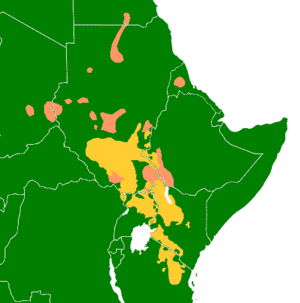Eastern Sudanic languages facts for kids
Quick facts for kids Eastern Sudanic |
|
|---|---|
| Geographic distribution: |
Egypt, Sudan, South Sudan, Eritrea, Ethiopia, Chad, Kenya, Tanzania, Uganda |
| Linguistic classification: | Nilo-Saharan?
|
| Subdivisions: |
Northern (k languages)
Nubian Nara Nyima Taman Meroitic? † Southern (n languages)
Nilotic Surmic Jebel Temein Daju Kuliak (rarely included)
Berta (rarely included)
|
| ISO 639-5: | sdv |
 Eastern Sudanic languages:
* Group k (orange) * Group n (yellow) |
|
The Eastern Sudanic languages are a group of nine language families. They are thought to be a part of the larger Nilo-Saharan language family. These languages are spoken across a huge area, from southern Egypt all the way to northern Tanzania.
Some of the oldest written examples of African languages come from the Eastern Sudanic group. These include Old Nubian and possibly Meroitic. The biggest branch of this family is Nilotic. These languages spread widely across East Africa due to people moving and settling new areas.
Before the Nilotic languages spread, most Eastern Sudanic languages were spoken in what is now Sudan. The name "Eastern Sudanic" refers to the eastern part of the Sudan region. It helps us tell them apart from Central Sudanic and Western Sudanic languages. Western Sudanic languages are now part of the Niger-Congo family.
A linguist named Lionel Bender (in 1980) found some shared words across Eastern Sudanic languages. These shared words, called isoglosses, help show their connection. Examples include *kutuk meaning "mouth" and *ku-lug-ut or *kVl(t) meaning "fish."
In older ways of classifying languages, the term "Sudanic languages" was used differently. It often meant languages similar to modern Nilo-Saharan, but without the Nilotic languages. Today, Nilotic languages are a very important part of the Eastern Sudanic group.
Some experts, like Güldemann (2018), think that the idea of Eastern Sudanic as one big family still needs more proof. He believes there is strong evidence for a link between Nilotic and Surmic languages. He also finds the evidence for a northern group, including Nubian, Nara, Nyima, Taman, and Meroitic, to be promising. However, Glottolog (2023), another language classification project, does not even agree that Surmic and Nilotic are related.
Contents
How Eastern Sudanic Languages Are Grouped
Linguists have different ideas about how the Eastern Sudanic languages are related. They often group them based on shared features.
Bender's Classification (2000)
Lionel Bender suggested grouping these languages into two main branches. He looked at whether the word for "I" (the first person singular pronoun) started with a /k/ sound or an /n/ sound.
| Eastern Sudanic |
|
|||||||||||||||||||||||||||||||||
Rilly's Classification (2009)
Claude Rilly (2009) proposed a different way to organize the Eastern Sudanic languages. His classification shows how some groups are more closely related than others.
| Eastern Sudanic |
|
|||||||||||||||||||||||||||||||||||||||||||||
Starostin's Classification (2015)
Starostin used a method called lexicostatistics to study language relationships. This method looks at how many words are similar between languages. He found strong support for Bender's Northern branch. However, he did not find as much support for the Southern branch.
Starostin believes that Eastern Sudanic is likely a real language family. He also thinks the link between Nubian, Tama, and Nara languages is very clear.
| Eastern Sudanic |
|
||||||||||||||||||||||||||||||||||||
Starostin noted that Nyima might be close to the Northern group, but not directly part of it. He also observed that Surmic, Nilotic, and Temein share some similarities. However, he said more research is needed to group them together. Jebel and Daju also have similarities with Surma and Nilotic.
Some other language families, like Kuliak and Berta, are sometimes included. But Starostin's research does not support this.
A similar classification was given by Starostin in 2014:
- Eastern Sudanic
- Tama-Nara-Nubian branch
- Tama
- Nara-Nubian
- Nara
- Nubian
- Surmic branch
- Northern Surmic (= Majang)
- Southern Surmic
- Southwest Surmic
- Southeast Surmic
- Nilotic branch
- Northern Nilotic
- Western Nilotic
- Eastern Nilotic
- Southern Nilotic
- Northern Nilotic
- Daju
- Nyimang
- Temein
- Jebel
- Tama-Nara-Nubian branch
Blench's Classification (2019, 2021)
Roger Blench (2019, 2021) also found support for Bender's Northern branch. He proposed his own structure based on how words are formed (morphology).
| East Sudanic |
|
|||||||||||||||||||||||||||||||||
Dimmendaal & Jakobi's Classification (< 2020)
Dimmendaal & Jakobi (2020) kept Bender's idea of a Southern branch. They also included the Berta language in their classification.
{{clade |label1=Eastern
Sudanic |1=
| Northern |
|
|||||||||||||||||||||||||||
| Southern |
|
|||||||||||||||||||||||||||

